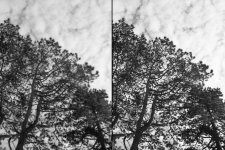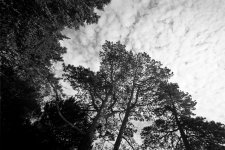teddy
Jose Morales
But consider this: One reason that I continue to work with film (for my personal work) is that I keep organized and detailed books of negative strips ... since the late 1980s. Along with those three-ring binders containing lots of negatives, I have contact sheets.
This is exactly what I do - and your point of view is valid too. Perhaps finding a balance is best.
davidswiss
Established
I note very little positive comments on the plustek series of scanners. I see online there is a new version out, the 8300i SE, which has little in the way of reviews, Anyone here use them ?
Coldkennels
Barnack-toting Brit.
I use the much earlier 8100 version. Honestly, I don't think much has changed in the way of performance between that model and more recent ones; I think they just put a new version of SilverFast in the box and change the version number, but I may be (very) wrong.I note very little positive comments on the plustek series of scanners. I see online there is a new version out, the 8300i SE, which has little in the way of reviews, Anyone here use them ?
Prior to buying the Plustek, I was mostly printing for the "real", final version of an image and using a Canoscan 9000f to digitise the negs, creating a searchable digital archive, and for online use. I was never overly happy with the Canoscan, but it was passable in the late 2000s, when screen resolutions were lower and displays were lower quality; on a modern device, scans from a Canoscan - even at the highest possible resolution - look bloody terrible. In comparison, the Plustek is almost too good - every single bit of grain will show up much more prominently than you'd get with a good wet print.
Here's a comparison between the two scanners - nothing too fancy, just a 100% crop of a quick grab shot on APX 100. Hilariously, the Canoscan version is actually the higher-res of the two (approx 3300x2200px vs 2600x1700px):

Here's the Plustek version of the full frame, so you can see how tight a crop this is:

I didn't add any sharpening to either of the individual files or the merged comparison in the process, either - what you see here is exactly what you get out of the scanner. The difference is so vast that I actually think there's more detail in a 35mm scan from the Plustek than there is in a 120 scan from the Canoscan, which is just so wrong.
The TL: DR? You get higher resolution than the average flatbed and the price isn't a whole lot higher, so the Plustek is obviously a better choice if you're looking for a dedicated scanner. The downside is you're limited to 35mm only, and as the neg carrier feeds in one frame at a time, there's no batch scanning to speak of. With the Canoscan, you can put 12 frames (2 x 6 frame strips) of 35mm into the scanner, adjust the exposure and settings for each frame, then start the scanner off and walk away. With the Plustek, it's a more involved process - you have to manually push the carrier over, prescan, adjust exposure, then do the final scan. Luckily it's quite fast per frame, but I still want to have a TV show or something on in the background while I do it if I'm scanning a whole roll.
I think wet printing and scanning the print is still a higher-quality option if you know what you're doing, but that's an even more involved process, so for 99% of things, the Plustek is more than good enough for me.
Godfrey
somewhat colored
When I make photographs, I prefer doing my own work as much as possible. So I process my own film when using a film camera and scan it myself. When shooting film, I work with Minox 8x11, 35mm, 6x4.5, 6x6, 6x9, and Polaroid SX-70 type cameras. I only shoot B&W film except with the Polaroid cameras ... I prefer an all digital capture workflow for anything color as it is both more capable and more flexible in my opinion, as well as being far less expensive and far less work on the film processing side of the game.
I have both flatbed and dedicated film scanners. Operated with VueScan, both return excellent results but the scanning work is a bit of tedium. This means I'm always looking to improve on the digital capture workflow, both for improved quality and for reduced tedium. In recent years, I've moved almost entirely to a copy camera approach rather than a scanner for doing this capture. The copy camera approach requires a bit more effort in doing the setup but reduces the amount of time it takes to digitize a set of photos, and I find that with the modern digital cameras at my disposal (Leica CL, Leica M10-M, Hasselblad 907x), the 16 to 50 Mpixel raw files it produces are of at least comparable quality to the various scanners' output, and are easier to render to my preference and satisfaction. Once set up, I can scan up to 200 exposures (negs or prints) in under an hour.
My scanning methodology is simple: I scan everything on a roll of film after getting the setup zero'ed in and then perform a default neg to positive and tone curve conversion in whatever digital image processing tools I'm using (currently Lightroom Classic). Once into the positive image domain, selection of individual frames to render to finish quality is much easier in the digital image processing domain, and that saves a huge amount of time and tedium.
I've been digitizing and rendering film images for a very long time .. nearly thirty years now .. and samples of some of my work are available for viewing on Flickr.com: GDG scanned images on Flickr.
enjoy, G
I have both flatbed and dedicated film scanners. Operated with VueScan, both return excellent results but the scanning work is a bit of tedium. This means I'm always looking to improve on the digital capture workflow, both for improved quality and for reduced tedium. In recent years, I've moved almost entirely to a copy camera approach rather than a scanner for doing this capture. The copy camera approach requires a bit more effort in doing the setup but reduces the amount of time it takes to digitize a set of photos, and I find that with the modern digital cameras at my disposal (Leica CL, Leica M10-M, Hasselblad 907x), the 16 to 50 Mpixel raw files it produces are of at least comparable quality to the various scanners' output, and are easier to render to my preference and satisfaction. Once set up, I can scan up to 200 exposures (negs or prints) in under an hour.
My scanning methodology is simple: I scan everything on a roll of film after getting the setup zero'ed in and then perform a default neg to positive and tone curve conversion in whatever digital image processing tools I'm using (currently Lightroom Classic). Once into the positive image domain, selection of individual frames to render to finish quality is much easier in the digital image processing domain, and that saves a huge amount of time and tedium.
I've been digitizing and rendering film images for a very long time .. nearly thirty years now .. and samples of some of my work are available for viewing on Flickr.com: GDG scanned images on Flickr.
enjoy, G
AlwaysOnAuto
Well-known
Godfrey
somewhat colored
That's good equipment, those Nikon bellows and such were very high grade quality.
I did essentially the same thing finding a Leitz Focusing Bellows-R and Macro-Elmar-R 100mm f/4 set for almost nothing, and have used that with adapters and with a couple other Leica R lenses on a bunch of different camera bodies over the years. A lot of the Leica R equipment went for very low prices when Leica discontinued the R system back in 2009 or so; prices have since floated back up a good way.
G
I did essentially the same thing finding a Leitz Focusing Bellows-R and Macro-Elmar-R 100mm f/4 set for almost nothing, and have used that with adapters and with a couple other Leica R lenses on a bunch of different camera bodies over the years. A lot of the Leica R equipment went for very low prices when Leica discontinued the R system back in 2009 or so; prices have since floated back up a good way.
G
Share:

